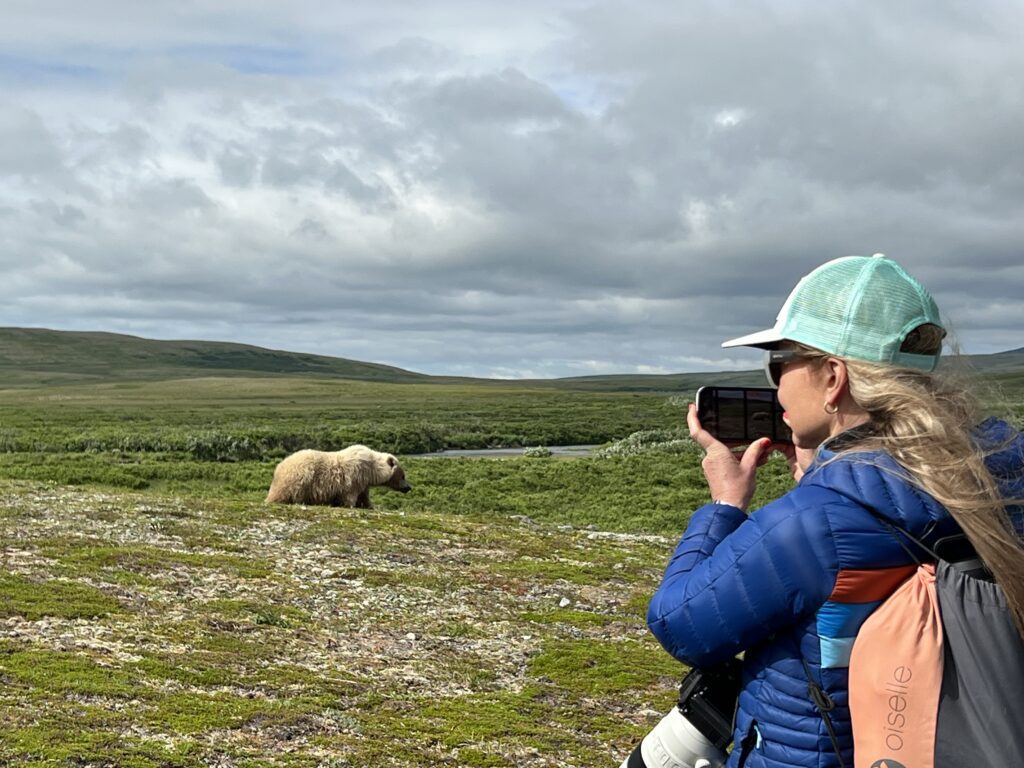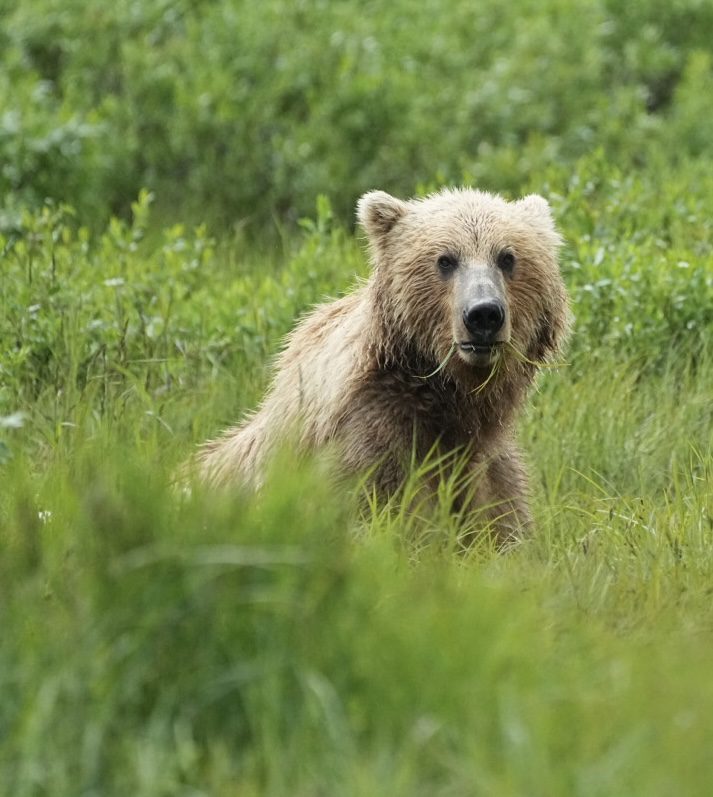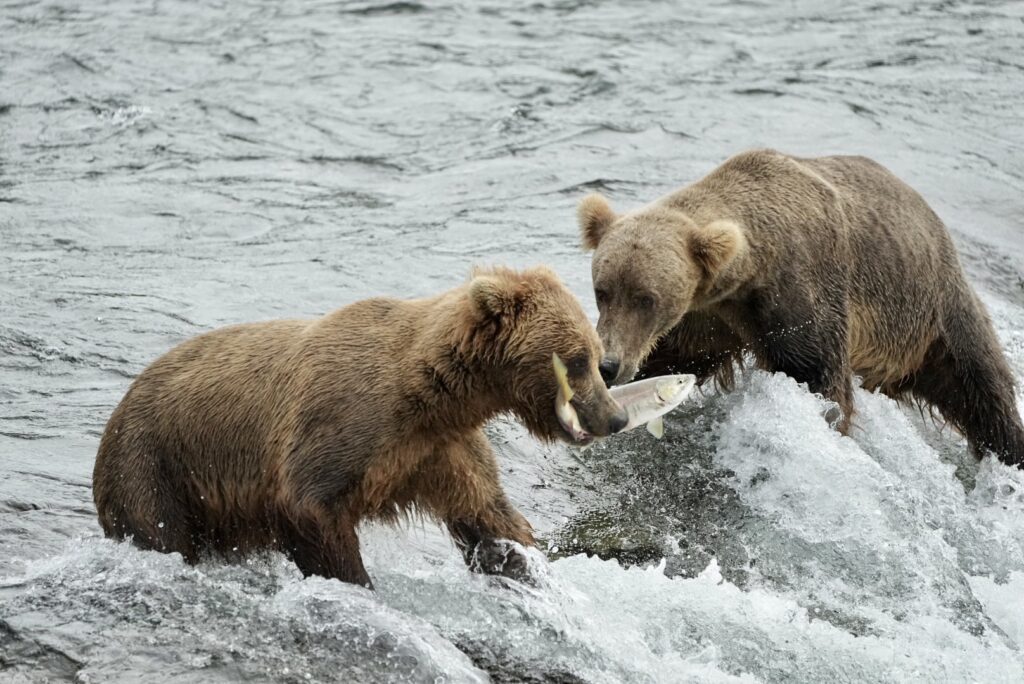Nestled in the remote wilderness of southern Alaska, Katmai National Park, offers a unique blend of volcanic landscape, abundant wildlife, and remote wilderness, making it an inviting destination for adventurers and nature enthusiasts. Located in southern Alaska, Katmai is home to the famous Brooks Falls, where visitors can watch brown bears in their natural habitat, especially during the salmon run. This park covers over 4 million acres of rugged terrain, including volcanoes, lakes, and rivers. It is Alaskan paradise and I highly recommend visiting this extraordinary park.

Best Time to Visit
The best time to visit Katmai National Park is during the summer months, from June to September. This period offers the warmest weather and the best opportunities for wildlife viewing, particularly brown bears at Brooks Falls. July is often considered the peak month for bear watching so prices are higher and accommodation availability is limited. Our goal was to see bears so we went in July. It was dry and sunny and we observed countless number of bears. Therefore, I recommend you visit during this time if bear viewing in your primary goal.

Access
Katmai is remote and accessible primarily by plane or boat. There are no roads that lead into the park. Many visitors fly into King Salmon via Anchorage and then take a smaller plane or a boat to reach the park. This isolation is part of the adventure and fun associated with visiting Katmai. We flew to Anchorage International Airport, took a taxi to Merril Field Airport, and then flew with Lake Clark Air to Port Alsworth. The short flight from Anchorage to Port Alsworth was stunning with views of snow covered mountains, rushing rivers, and vibrant blue lakes. It was enjoyable and exciting. This was my first time in a float plane and I was pleasantly surprised at how smooth the ride was for such a small aircraft. Plus, the views were epic.
Remote Wilderness Experience
We stayed at The Farm Lodge near the headquarters of Lake Clark National Park in Port Alsworth. Lake Clark Air has a fleet of floatplanes and bush planes so they are able to provide lodge guests with access to the remote areas of Katmai National Park and surrounding areas. We accessed the park daily via float or bush plane rides with them. It was incredibly convenient and the accommodations were excellent. I highly recommend staying at The Farm Lodge or at another lodge in the wilderness away from the more populated cities. You will be closer to the National Parks and be able to experience more beauty and have an authentic visit immersed in the Alaskan wilderness.
We chose a three day adventure package for bear viewing in Katmai National Park. Therefore, we were flown to a new location each day to observe brown bears in their natural environments. One day we explored a river in the tundra, another day we visited Brooks Falls, and the final day was spent near the coast. These three days were the highlight of my first trip to Alaska. There is so much varied beauty within the park.
The Bears of Katmai
Katmai National Park is known as one of best places to watch brown bears in their natural habitat and it did not disappoint. There are over 2,200 bears residing in the park, which makes it one of the largest concentrations of brown bears on Earth. The bear population thrives due to the abundant food sources available, particularly salmon as they swim upstream to spawn.

The park’s vast landscapes of forests, alpine meadows, and lowlands create the perfect backdrop for bear watching, particularly during the salmon run from June to September. During this time, bears congregate at streams and rivers feasting on salmon, preparing for the long winter ahead. Therefore, Katmai National Park is a bucket-list destination for wildlife enthusiasts and photographers alike. You will be delighted to see so many bears in one area.
Brooks Falls: The Heart of Bear Watching

The epicenter of bear watching in Katmai is Brooks Falls, where visitors can witness the iconic sight of bears catching leaping salmon. The falls offer a natural barrier to the salmon, making them easy prey for the waiting bears. The bears take advantage of this by standing atop the falls or waiting in the water to catch a fish. This spectacle attracts visitors from around the world, eager to capture the moment a bear successfully snatches a fish from mid-air and to watch the dynamic interactions between individual bears. It was surprising to watch the large males balance atop the falls in the rushing river and not fall. Supposedly, falls do happen, but we did not see any. Sitting atop the falls is a highly valuable fishing position so bear fights happen over these desired spots and only large males fish atop the falls.
The best time to visit Brooks Falls is from late June through July, which coincides with the peak of the salmon run. During this period, bear activity at the falls is at its highest, offering the best chances to observe their fishing behavior. The exact time varies by year and affects the bears. The salmon did not arrive until July of this year, which was later than usual, so some of the bears were thinner than expected. You may still see bears in the area in September, feeding on the remaining salmon to build up fat reserves for the winter. Bears need to consume large quantities of salmon over a period of time so they are prepared to survive Alaska’s harsh winters.
The park has established elevated viewing platforms near Brooks Falls, designed to provide safe and unobtrusive spots for bear watching. These platforms allow visitors to get remarkably close to the bears while minimizing human impact on their natural behaviors. The experience of watching these powerful creatures in such close proximity is both exhilarating and humbling. It was mesmerizing watching the bears around the falls, but there were so many other people clustered around the main platform. During July and August, you should expect large crowds of people on the platform closest to the falls. We arrived early in the morning and the park was already busy. Also, a park ranger is stationed near the falls platform to allow a limited number of people on the platform and you are allowed only fifteen minutes to view the bears before you must leave. However, you can rejoin the platform line for another fifteen minutes if you chose. We were both ready to leave the crowded area and happily found other areas along the elevated platform and trails to see bears.
Access to Brooks Falls is typically by floatplane from Port Alsworth or King Salmon, which is connected by commercial flights to Anchorage. Given the popularity of bearing watching at Brooks Falls, make sure you plan overnight stays at the Brooks Camp Campground or the nearby lodge well in advance, especially during the peak viewing season. Reservations are typically needed at least one year in advance.
Safety and Etiquette
Safety is a paramount concern while bear watching. Park Rangers are around and will instruct you to maintain a safe distance from the bears, never to approach or feed them, be quiet, and to follow all park regulations and guidelines to ensure both their safety and the welfare of the bears. This includes using designated paths, and not eating or drinking near the viewing platforms. These rangers are always present to monitor bear activity, assist visitors, and provide educational programs about the bears and the park’s ecosystem. This helps ensure that humans and bears coexist peacefully in these shared spaces. We are entering their environment so it imperative we do not disturb their behavior or routines. Plus, viewing bears in Katmai is such a special experience and we should make sure it stays this way.
Beyond Brooks Falls
While Brooks Falls is the most famous spot for bear watching in Katmai, the park’s extensive wilderness offers other areas where visitors can encounter bears in a more secluded setting. I recommend visiting Brooks Falls since it is such a unique experience with the falls and elevated platforms. However, I preferred the other locations we flew to for bear viewing. Our guide was crucial for safety and knowledge. Exploring the park with a guide can enhance the chances of seeing bears in various environments, such as sedge meadows, beaches, and other river systems, each providing a different context for observing and understanding the lives of these fascinating animals.
One day we flew in a float plane to an area along Moraine Creek where brown bears gather to fish. Our guide escorted us through the tundra and along the river to watch the numerous bears in the area. It was action packed with bears charging each other and chasing fish. We observed bears fishing in the water, snacking on grass, and defending their fishing territory. Bears do not appreciate other bears getting close to their fishing spot and they will charge at each other to communicate that. Females with cubs tend to find more isolated fishing areas away from large males to avoid any trouble. The red colored salmon are easily visible, plentiful, and it looks like there is more than enough fish for each bear. However, catching a fish is not as easy at it looks and each bear has their own preferred method of catching them. Some methods are more successful than others.
We observed these fishes strategies:
- Stand and wait: Bears will stand on top of Brooks Falls and wait for sockeye salmon to jump close enough to catch in their mouths.
- Dash and grab: Bears often chase fish and attempt to pin them to the river bottom with their paws. This technique did not seem to be very successful while we were watching.
- Snorkeling: Bears that snorkel stick their head under the water to look for fish. Sometimes they walk around like this and this behavior is very entertaining to watch.

